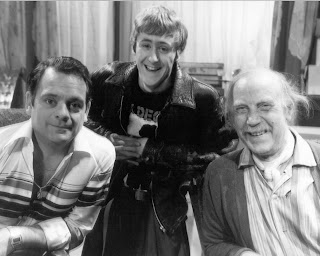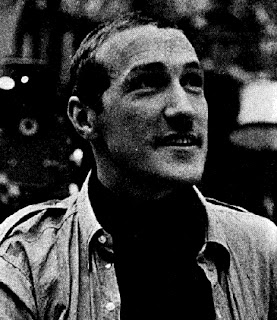They all beat the first series of Only Fools and Horses.... in the ratings.
Blake's Seven won 8.49 million across its 13 episodes shown from 28th September; the 6-part Triffids serial, beginning Thursday 10th Sept, was watched by 7.95m; and an average 9.24m tuned in to watch the young vet from All Creatures Great and Small establish himself as the star of the then 17 year-old cult series. And I thought science fiction wasn't popular back then.
Only Fools, on the other hand, mustered just 7.7m for its 6 episodes beginning Tuesday 8th September at 8.30pm.
 |
| Radio Times listing for the first episode of Only Fools and Horses.... (edition dated 5-11 September 1981) |
But it's perhaps not that much of a mystery. What the show's creator, the late John Sullivan, has said on the subject probably covers it: "we didn't really get any publicity and the show went out in a very bad slot" ["Only Fools and Horses: The Official Inside Story" by Steve Clark, Splendid Books 2011]. Fools was placed opposite the Euston Films period serial The Flame Trees of Thika, which had the upper hand by about 3½ million.
ITV in fact had a particularly strong schedule on those Tuesday evenings, with Thika preceded at 8pm by the second series of the Thames Television version of The Morecambe and Wise Show, always a ratings juggernaut and no exception here. Fools' lead-in on BBC1 was a repeat run of US import The Rockford Files.
One also wonders if the series' title had anything to do with the lack of interest. Once one has heard the lyric "why do only fools and horses work?" it clicks into place, and it's a stroke of genius to include it in the title music - but that was only introduced in Series 2. The low viewership early on mean that few are probably aware that the first series had a completely different, instrumental theme tune composed by Ronnie Hazlehurst - a Cockney honky tonk concoction much hated by all.
The 'Radio Times' feature article introducing the series - about the only substantial information a viewer was likely to find in 1981 - makes no mention of the phrase's significance either, and it was never addressed onscreen. Might one's eye pass over an obscure-sounding title in the listings..?
 |
| David Jason, Nicholas Lyndhurst and Lennard Pearce in an early publicity shot. Publicity?! Harpo Marx would've made more noise! |
Mr Gilbert even addresses the subject of the less than stellar ratings: "Episode 1 got in the BARB ratings but there was no Burt Lancaster movie on BBC2 that night. When Burt was competing, Fools fell out [of the list]"! Just out of interest, those movies starring the incomparable Mr Lancaster that played opposite episodes 2-5 of Fools were Run Silent, Run Deep (1958); Trapeze (1956); Birdman of Alcatraz (1962); and The Train (1964).
So, not the greatest start for the show that went on to command the nation but perhaps it was just meant to be. That initial series isn't the best by any stretch, and some of the episodes, for instance 'A Slow Bus to Chingford', are amongst the weakest of them all.
Fortunately it seems as though a second series was never in much doubt. The BBC had a policy of nurturing shows in those days, allowing them "the right to fail" and so with Sullivan under contract, the Trotters were set to return at least once more.
But first came a Christmas special, commissioned and recorded at short notice for broadcast on Monday 28th December where once again it was outstripped by something the BBC didn't really like. The single spin-off the original version of Doctor Who enjoyed, if that's the word, a vehicle for the recently departed robotic mutt K-9, also aired that Holiday Monday. K-9 and Company, 8.4m; Only Fools and Horses, 7.5m...
 |
| The Trotters returned for a second run in 1982. This is where I came in. |
Competition on ITV wasn't so strong - episode 1, "The Long Legs of the Law", the funniest episode so far, in which Rodney embarks on an ill-advised relationship with a policewoman, played opposite a reshowing of the 1974 Roger Moore film Gold. It still managed 10.5m against the Trotters' 7.7m.
Thereafter, the scheduling eased up some more - Season 2 of American soap Falcon Crest (showing only a couple of weeks behind its US prime time airdates) played opposite the remainder of the run. Not exactly their best guns.
And I agree with the notion that Thursday is a much better night for comedy, psychologically speaking. Series 2 is where I first caught the show, in my first term at grammar school and hating it - luckily, there's only one more day to go before the weekend. Or if it's mid-term, none! As was the case on 28th October 1982 when I tuned into my very first episode, "Ashes to Ashes", where Del and Rodney are tasked with disposing of the ashes of Trigger's late gran - and loved every minute. I never missed from that day.
Still, there was always something doing better - "Ashes to Ashes" followed a new series of the Ronnie Corbett vehicle Sorry!, which got 11.1m to Fools' 9.8m. No comment.
A string of fine episodes followed: "A Losing Streak", in which Del bets everything the family owns to take on Boycie at poker; "The Yellow Peril", where they redecorate a Chinese restaurant with what turns out to be luminous paint; and, last but not least, the famous "A Touch of Glass" featuring one of the finest visual gags in the history of television comedy. With this episode the show finally cracked the 10 million mark.
 |
| After two series of Only Fools, John Sullivan created Just Good Friends, starring Jan Francis and Paul Nicholas |
A special followed that Christmas, and then, according to John Sullivan, there was silence from the BBC. Only Fools and Horses.... hadn't set the world aflame and no third commission was forthcoming. The fact that they were dragging their heels over a show which had finished its last run on such a strong note as the chandelier gag is baffling to me.
John Sullivan moved on to a new show, the romantic comedy Just Good Friends - which incidentally was the immediate smash that Fools hadn't been, averaging almost 11m for its first series, five out of seven episodes of which took 1st place in the BBC1 Top Ten.
Nicholas Lyndhurst returned to an earlier sitcom success - a belated fourth series of bitterweet Carla Lane masterpiece Butterflies (which managed 7½m on BBC2, all seven episodes at No.1).
 |
| The late John Sullivan, with typewriter, pictured in 1981 [Radio Times] |
So things weren't looking good. However, help was at hand in the unlikely form of summer filler repeats. On Tuesday 5th July 1983 at 8.30pm, a re-run of Series 2 began on BBC1 (Series 1 wasn't re-shown until afternoons in 1987). What happened next, from Sullivan himself:
"[My wife] and I took the kids to Hastings and we were staying in a caravan when I picked up a paper and glanced at the ratings and there was Only Fools. It was as if the public had finally noticed the show. If that hadn't happened ... there was no way a third series would have been commissioned. By the time I got back home I was offered two more series"
["Only Fools and Horses: The Official Inside Story" by Steve Clark, Splendid Books 2011]
 |
| Maybe, just maybe, the newspaper article that John Sullivan saw on his family holiday, showing Only Fools in the Top 10 charts. 'Daily Express', Mon 1 Aug 1983 |
And so at lightning speed a third series of the adventures of the Trotter clan was commissioned, being mentioned in the Express on 24th August as having a new 7-episode run. Production began on 2nd September.
The series began on Thursday 17th November, at 8.30pm, a week after Just Good Friends finished. Given the alacrity of the production, it is astonishing that this is arguably the pinnacle of Fools. Everything has come together in a remarkable way, with David Jason, Nicholas Lyndhurst, Lennard Pearce, John Sullivan and producer/director Ray Butt producing comedy gold rivalling the likes of Fawlty Towers.
 |
| Unexpectedly back again, but most welcome, in 1983 |
So many sensational episodes that series: 'Healthy Competition' with Rodney going it alone (with Mickey Pearce); 'Friday the 14th', the Trotters in a remote cottage, planning on some salmon poaching and being menaced by a potential axe-murderer; 'May the Force Be With You', the first appearance of Del-boy's arch nemesis Roy Slater, ex-schoolfriend and bent Detective Inspector; 'Who's A Pretty Boy', redecorating Denzil and Corinne's flat and sauteing the latter's pet canary into the bargain; and the sublime Christmas special 'Thicker than Water', with the return of their absconded father Reg after 18 years.
The show started to make regular appearances in the BBC1 Top Ten. Average audience jumped to 10.46m with the audience rising over the seven weeks, finishing with 11.9m for 'Who's a Pretty Boy'. ITV competition was - usually - another cruddy import, this time the debuting Hotel, based on the Arthur Hailey novel and starring James Brolin. There was still room for ITV to win the round mind you - the televising of the 1983 Miss World contest beat Only Fools' 'Healthy Competition' on the 24th Oct by over 5m; and the following week the Hotel pilot beat 'Friday the 14th' by almost 3m. Bloody hellfire.
Anyway, for the first of many occasions over the next two decades, the Trotters were promoted to Christmas Day for that year's special, playing at 9.35pm to 10.8m directly after a feature length All Creatures Great and Small with 12.2m. On ITV at the time was the Peter Sellers' Clouseau pic Revenge of the Pink Panther, but I dunno how many people tuned in to it. Not as many, I don't think.
 |
| Peter Woodthorpe in his one and only appearance as Reg Trotter, in 'Thicker Than Water'. Just as well it was perfect. |
1983 had turned out to be a very good year for the show, despite starting off on such an ambiguous note. Series 3 was the first of many to be BAFTA-nominated, for Best Comedy Series, losing out to Hi-Di-Hi! And not many sitcoms can claim that.
Summer 1984, and it was the turn of Series 3 to gain a summer repeat. All 7 episodes were shown from 16th July to 27th August (Mondays usually at 8pm), and "Homesick" kicked off the run with 10.4m and the No.1 place in the BBC1 chart. In fact, this and two other episodes outstripped the viewership of their first screening, which can't be bad. The average was 10m or so, not much less than the original.
Only Fools and Horses.... was finally on its way to becoming the most popular British sitcom ever made.
To be continued...
























